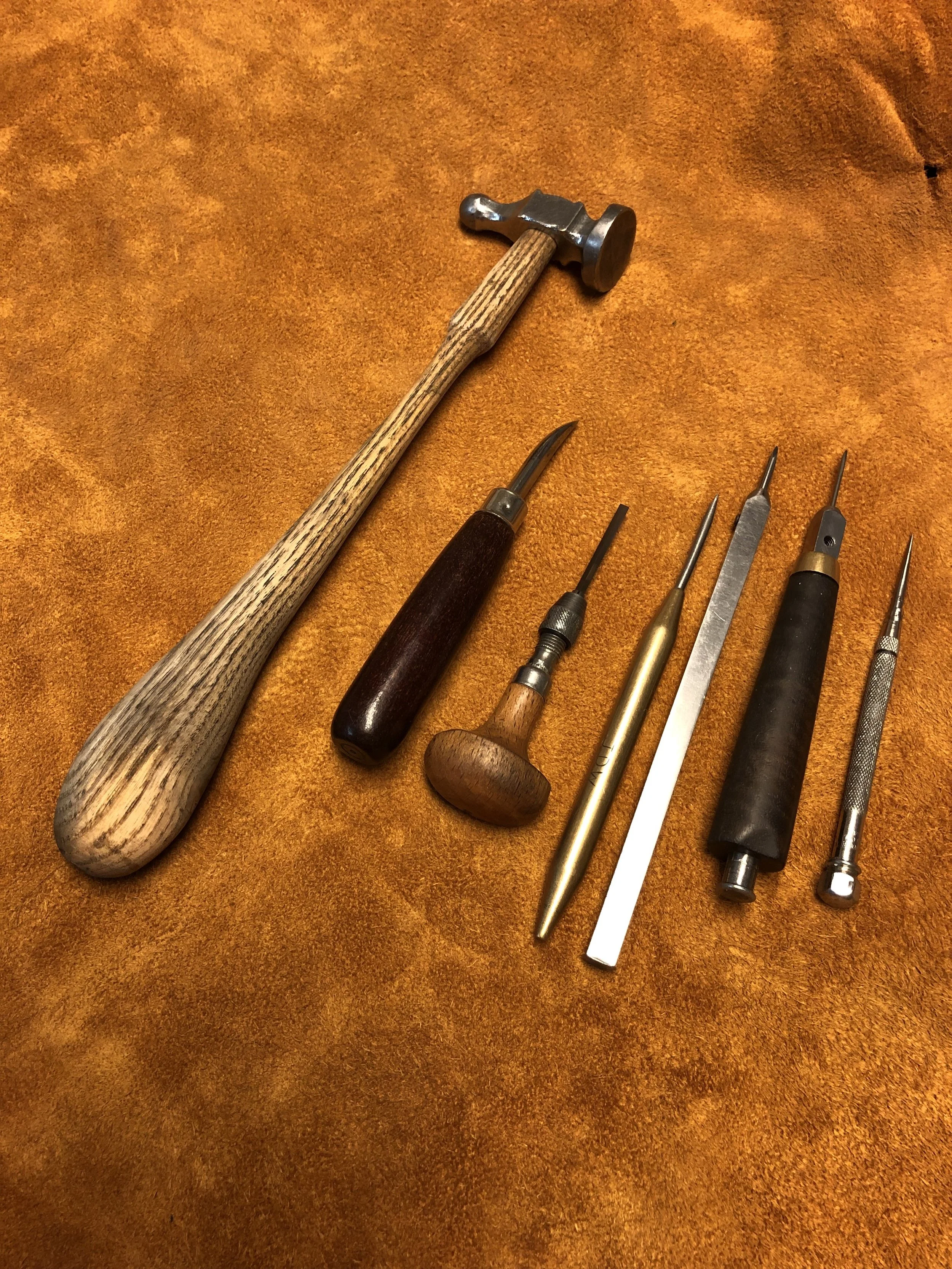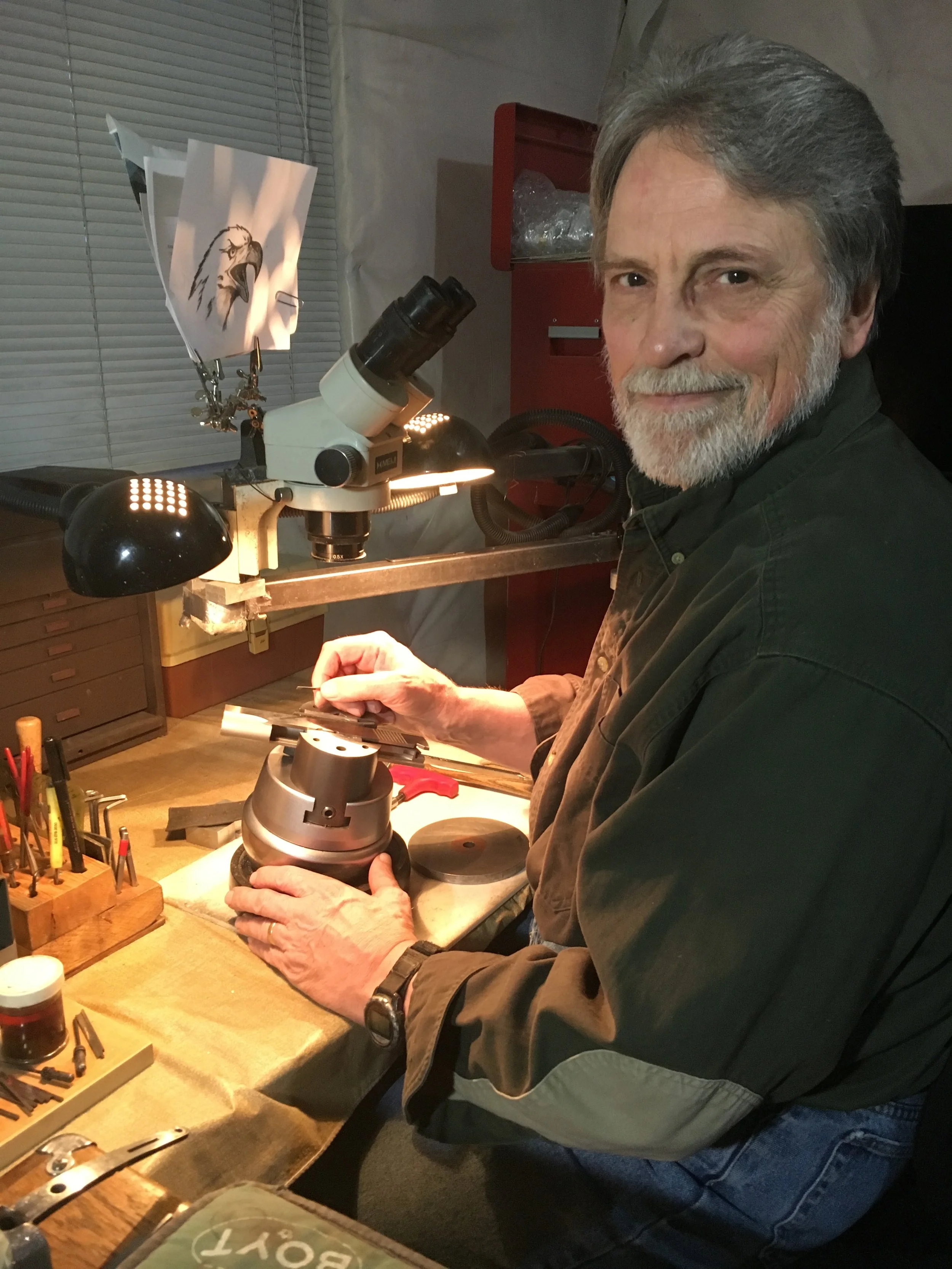So You Want To Learn To Engrave
Basic tools. Left to right: Hammer, burnisher, push graver, gold inlay tool, graver holder, small graver holder, layout scribe
I’m often asked the question of “Where can I learn to engrave?”
I’ll make two suggestions that I think might work for most people. NRA puts on summer courses that last for one to two weeks at various gunsmithing colleges. Back in 1991 I attended an advanced engraving course at Trinidad, Colorado. At that time the beginning engraving class taught basic hammer and chisel engraving, how to lay out patterns, and graver sharpening. By the end of the class, the student would have the knowledge of how to engrave and what tools and equipment they would need. They also would probably have had enough exposure to engraving to know if pursuing a career interested them. My instructor was FEGA guild member John Barraclough, and I cannot speak more highly of any instructor. I believe John no longer teaches classes.
GRS in Emporia, Kansas frequently holds engraving classes. I’ve not attended any of theirs, but I know people who have and who were quite satisfied. They will undoubtedly teach you engraving using their equipment and probably not traditional hammer and chisel or push graving.
Power equipment has become quite expensive, which is why it might be more cost effective to attend one of the seminars or classes where equipment is furnished rather than making the large capital outlay. When I started engraving in 1983, a fairly complete outfit could be purchased for $1,000. The same equipment will cost $4,000-5,000 today.
What equipment does one need? If firearms engraving, an engraver’s ball vise is necessary. I’ve used the GRS MagnaBlock vise for 36 years and have been totally satisfied. If firearms engraving, don’t waste money on a small jeweler’s vise. I would buy a GRS Power Hone and their basic sharpening fixture. With proper sharpened gravers, the beginner will quickly know if they are at fault as they begin cutting and not the graver. Any engraving ‘feel’ gained will be repeatable since the gravers are exactly the same. Some form of magnification to save strain on the eyes will be needed. I worked for ten years using a 4” common round magnifying glass with the handle attached to a stand. I moved on to a #5 Optivisor, then to a binocular microscope. You cannot engrave better than you can see.
I have purchased gravers from GRS and Ngraver Company. I probably have a lifetime supply of 1/8” carbide gravers from Ngraver. Theirs are beautifully ground, and I have used them exclusively for probably twenty years. I currently only use carbide gravers. Firearms can be very difficult to cut, particularly those made of stainless steel, and carbide is the best material I’ve found to engrave with.
My old GRS Gravermeister has been rebuilt twice over the years, and it’s about due for a third trip back to the factory. It has served me well. Don Glaser was its inventor, and a nicer guy you could not have met. He gave me a 30 minute instruction session in 1983, and that lasted me for eight years until I took the NRA summer course. I have a backup Gravermeister, Power Hone, and Magnablock in case any one fails (I’ve worn out each of those items over the years). Joe Average doesn’t need a backup unit, but being in Alaska, shipping time can be long. As a full-time master engraver depending on my equipment for my main source of income, I’m a bit different.
I’ve also often been asked to teach someone how to engrave. I always resisted, and as I found out, rightly so. For much of my engraving career I simply didn’t have the time to take someone with zero knowledge and teach them engraving basics. It would take a huge amount of time I simply didn’t have. I found that literally 100% of these people had no idea of what they were asking of me. I eventually began steering them towards the two sources of learning I outlined earlier. Not a single one had the drive or interest to follow through. I never found a single individual with the drive and commitment to become a serious engraver. What they did want was for me to teach them over the course of a couple hours to BECOME ME. Sorry, doesn’t work that way.
From 2010 to almost the end of 2016 I engraved eleven hours a day, seven days a week. There simply was not time to do anything but engrave, exercise, eat, and sleep. I love to read, but for those years only in the hotel at night while attending the annual SHOT Show in Las Vegas or on the plane could I open a book. No other master engraver I know of in the US would/could commit to that much work. It actually wasn’t all that difficult, as I truly love to engrave. I’d rather spend 11 hours a day doing something I love, than 2 hours at something I hate (even for the same money!). Engraving is the work niche I best fit into. I’ve been involved with firearms my entire life, and engraving has been a rewarding part, both creatively and financially. The beginner obviously doesn’t need to spend as much time engraving as I do, but for progress to be made, there has to be commitment.
For those who might want to become an engraver, I hope this helps. Best to you.
Jim


